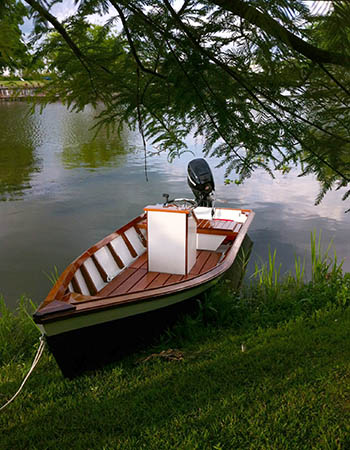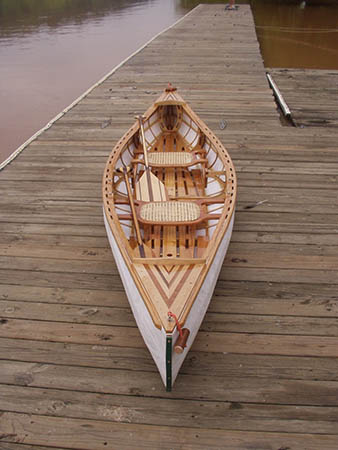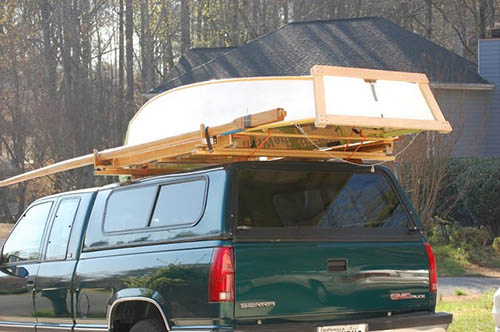In last issue’s eZine, after an evening spent on a Minnesota lake, Rob noted the presence of several wooden boats, started dreaming (again) about building one, and wondered how many of you had done so. The answer? A LOT. Several of whom shared their boat building resources. – Editor

“Enjoy the eZine (when work allows for some downtime) and wanted to chime in on woodworkers and boat building. I live in the suburbs of New Orleans and am a weekend woodworker (when work allows) and was able to join my two interests a few years back. I like to build things and always wanted a boat, so I went searching for some classes on either. Found the Center for Traditional Louisiana Boatbuilding and hit the jackpot.
“They offer supervised boat building (more so than a class), and I had an excellent mentor, Danny Weimer, who is a very talented woodworker and contractor by trade. Spent the next year and half on Monday evenings driving ‘down the bayou’ to work on my dreamboat. My skill level and the fact that I was only able to work for a few hours a week is what caused the project to go on for so long. The At Last is a 15-foot 7-inch lake/bayou skiff made of 3/8-inch marine plywood and Spanish cedar, all wood construction with no fiberglass at all. It was an opportunity that I will always cherish, and she is a great source of pride for me. Gave me the opportunity to learn so much and to put some of my skills to the test. Met some wonderful and very talented people and am proud to say that I was one of the first women to build a boat with them, but I am certainly not the last as they have had a few more talented ladies build pirogues, standup paddleboards and assorted watercraft since.
“Thought I’d share with you and encourage you to get out and build that boat. You won’t regret it! (Although your bank account might.)” – Kelli Mascaro
“I built a 16-foot redwood strip canoe about 20 years ago. It still hangs in my garage and gets occasional use. I used plans from the Minnesota Canoe Association.” – Earl Slack

“I built a 4′ X 16′ mahogany Port Aransas skiff three years ago and had a blast! It was built at the Farley Boat Works in Port Aransas, Texas. Farley Boat Works was the last major wooden builder on the Texas coast, succumbing in 1942 to fiberglass and more compact, powerful outboard engines. In 2011, the property was purchased by the Port Aransas Preservation Historical Society (museum) to preserve the area’s nautical history. Today, it is a nautical museum and a wooden boat building facility with the theme ‘We will help you build your wooden boat.’” – Michael McClelland

“I just wanted to say thanks for tossing the spotlight on the magical craft of building wooden boats. Despite their beauty, these vessels (and their builders) are often overlooked. I’ve attached a few images of the ’39 D-class hydro which I’m currently building. If interested, you can find images of it, and the other boats which I’ve built and restored here.” – Todd Damon
“Always a big place in my life for wood boats. As a young child, I watched my dad, uncle and grandfather build cypress pirogues in the garage. I was awestruck with tools and creating with wood from that moment forward. I spent over 20 years, from 1967 to 1989, restoring and renovating old wood yachts and sailboats in the 20-60 foot range when I lived in New Orleans. There was virtually no competition except for a couple of seasoned veterans who were good friends. I never wanted to be part of the highly competitive mass of woodworkers that built houses, cabinets. etc. I found this to be quite creative and an outstanding way to develop my skills with flowing compound curves. That experience has had a lot of influence for what I create today.” – Greg Little
“Many years ago (about 25, if I remember), I was lucky enough to build a 15-1/2 foot sailing skiff. She was based on the Phil Bolger-drawn Gypsy. I picked up the plans from Build the New Instant Boats by Harold “Dynamite” Payson. She was a lot of fun sailing in the protected waters of the Little Peconic, Long Island, New York. She was easy to build and one of my first woodworking projects outside of a desk here, a bookcase there. Wish I could find the pictures! I recommend the tack and tape method promoted by Mssrs. Bolger and Payson for beginners. They are not too complex, but there is an amount of woodworking skill involved.” – Phil Imperato

“If I had more space to store the ones I’d like to try and build, I’d have more boats. As it is now, I have two boats suspended over my wife’s car in the garage and one stored in our family room. Back in 2005, I wanted a boat to go fishing. However, here were the criteria that I had: 1. Inexpensive to build. 2. Light. 3. No fiberglass and resin required. I decided that Skin-On-Frame (SOF) boats would be the easiest to build. So this was the result of my first attempt at building a SOF boat. I had no plans to follow and just winged it.
“This 12-foot canoe weighs in at 48 pounds. I think materials cost was under $300. This took me about 10 months of spare time while still working full-time. After that, I wanted to build another but faster boat. After much research, I decided to make a replica of a baidarka, Aleutian sea kayak. Although very tippy, it performs well. It’s 16 feet 8 inches long and 22 inches wide and weighs in at 38 pounds. Cost of materials around $300. This also took me about 10 months of spare time. The frame consists of 73 pieces of wood that are all lashed together with artificial sinew. It’s a shame that all the framework is hidden.

“After building those two boats, I wanted a boat that I didn’t have to paddle.The result was this 12-foot sailboat with a hull that weighs in at about 100 pounds. I think I spent around $800 in materials and it took me about 17 months of spare time to build it. It has a 16-foot mast. It’s also car-toppable.
“The white material is TYVEK Homewrap. Even the sail is made of Tyvek. Actually, all the boats have 3 layers of Tyvek that is laminated with contact cement. Keeping them stored inside, out of the sun, is important cause the Tyvek is not UV-resistant. Of course, a coat or two of latex paint would help with the UV protection.” – Alex P
“Absolutely! My father had boats before he met my mother and nothing was better than messing around the boatyard in the spring. Learned much from him…all wood in those days, 70+ years ago. After college and moving to the Virgin Islands, I finished my first ‘just out of the mold’ 30-foot sailboat, then sailing her 10,000 miles. Since then, I lived aboard for 18 years, taught sailing and fixed everything aboard, wood or otherwise. On newer boats, I’ve sailed the miles for nearly four times around the world. I built up a large set of tools and, now retired, I fix, modify, refinish, design and build everything in our house. Kitchens, cabinets, Prairie settles, Murphy beds, decks, stairs, doors … the boat building skills come in really handy.” – David Kummerle
“I am definitely showing my age when I remember when almost all small (less than 35 feet) boats were made of wood. A spring ritual was caulking the seams with oakum, especially on clinker built boats. We used to sink the row boats to let the slats swell and close the gaps. Once marine plywood became available, many boats were built with it. I built four different boats myself. I liked to use maple for the keel and bowsprit and yellow cedar for the frames. When fiberglass first became available, it was used to cover the hull of plywood boats!” – Ron Orr
“Those folks probably haven’t known you very long if they still laugh at your jokes. (Yuk, yuk.) About building boats: I have built several boats but they were all under 10 feet, at the request of the people that wanted them. They were of the small water/ponds/sloughs size for fishing and mostly by just one person in the boat. None of the boats had anything for power beyond an electric trolling motor and a paddle, but they did what was requested and lasted, some for over 10 years. The last boat was built without any mechanical fasteners, only epoxy and fiberglass. That made for a very light boat, but it was tough enough I believe one could pound nails with it.
“I, too, have had the urge to build larger, but fortunately have been able to bypass that urge and hope I continue to do so. As is often said, ‘A boat is a hole in the water into which one pours money.’ I have found a better purpose for my money is in more woodworking tools. Looking at it now, I could have a very large boat for all the tools I have. Take care and just go fishing with someone that already has a boat.” – Bob Hoyle
Some readers might not have built a wooden boat, but they have restored one (or more). – Editor
“I haven’t as yet built one, though I’ve been toying with the idea of building a sailing catamaran (for the last 20 years or more). I’ve yet to succumb to that siren’s call: the main reason is I’ve never had enough space! But now I’ve got 1.48 acres and there is a pad (that I’m going to build a pole barn on), that should give me enough space for a train layout (the garden sized trains) and space to start four or five 25-footers. The pad is 100 feet x 27 feet.
“I worked for a boatyard at Marina Del Rey between high school and my service in the Navy, 1968-1972. I worked on several all-wood boats. The most memorable was a 38-fott Kettenburg racing sloop. We stripped her anti-fouling paint and gave her a new bottom paint job, plus we varnished all of the topside teak and mahogany. A lot of work, but I enjoyed it, plus we took her to Catalina for the weekend and got to race with several other boats on the way back.” – J. Eric Pennestri
“I restored a 16-foot mahogany dual-cockpit cruiser of unknown make when I was 16. Didn’t really know what it was when I bought it for $150 with a lot of coats of navy surplus gray paint and a 25hp Evinrude outboard on it. But I was taking high school woodshop at the time and the instructor used only mahogany in the class, so I recognized it when I started to work on it. It was really in good shape under all that protective paint, so I took it down to bare wood and put marine varnish on it, plus fiberglassed it from the waterline down. It was a beauty, but the style then was flashy molded fiberglass boats with teal or red tail fins and the girls didn’t like my funny-looking old boat (could just barely pull one skier out of the water, couldn’t throw roostertails), so I sold it and bought a flashy, powerful ski rig that could get up on plane pulling multiple skiers and throw huge roostertails. Turns out, it could also crash into the docks at high speed, helmed by a friend, as I watched from the shore. Always wanted to buy an original Chris-Craft or Garwood 19 footer (no money) or make one (no time). Those problems have been solved but led to a new one (no energy). Well, just enough to go to wooden boat shows. You could build one for all of us that wanted to but never could, and we could live vicariously through you! Go for it, Rob!” – Mike Anderson
“When I began thinking about building a boat, I realized that I had some experience that would apply. About 20 years ago, I bought a classic Chris-Craft cabin cruiser for a song and a dance. It needed a little work, but was basically sound, was what my father-in-law said. I spent the next eight years trying to locate and repair all the little things that needed a little work. A wooden boat is really just a collection of sticks — each completely different from the next.
“I began by attempting to replace the cockpit deck that was badly delaminated plywood. I carefully took all the panels up from the bulwarks first — they were held in place with some curiously shaped backing blocks. Each was carefully removed and marked for its position in the puzzle. They all came home to be duplicated in nice new mahogany and prepared for the rebuild. Work on the boat was largely at night and on the weekends. I lived about 40 minutes away, so I seldom went down to it during the week. Instead, I spent my time scrupulously duplicating the odd angles these backing blocks were cut to.
“I used the excuse to buy my first band saw and a benchtop belt sander with a 6-inch wheel on the side — both necessary to get those angles correct. It took me a long time to get the pieces just right — the whole process was actually kind of rewarding. Who cared that replacing that cockpit sole was into its second month of weekends? Rebuilding this thing, I became a fan of these old CC cruisers. This one was thoroughly disreputable inside (since I hadn’t gotten to that area yet), but not too bad outside. We could use her every weekend if we wanted … I was to the point that I started researching the company.
“That was when I stumbled upon an old documentary on Chris-Craft that showed actual building going on in the plant around the time mine was being built for the first time. As they panned slowly across the manufacturing floor, I noticed a craftsman in the middle foreground doing something familiar. I watched carefully as the worker went over to a large pile of scraps and cutoffs, pulled out a piece at random (unconcerned about the weird angles that the piece had been cut to) and took it to a band saw to cutout a workable backer block in a matter of seconds; he had it screwed down in the cockpit in a matter of only a few more seconds. The angles I’d spent hours painfully duplicating were just the result of using scrap to fashion the backer blocks. The work proceeded at a new pace after that.
“Lesson learned: a little research upfront – and perhaps a class or two at the Center for Wooden Boats — would have probably covered that one. I’ll keep it in mind as I build the weekender sailboat I’m thinking of.” – Jeff Smith
A couple of people had comments about the boats found on Lake Minnetonka, where Rob took his cruise. – Editor
“If ‘last night’ was 8/7/17, many of the wooden boats were involved with a Tapping History cruise on the ultimate wooden boat on Minnetonka, the Steamboat Minnehaha. Built in 1905/1906, launched in 1906, scuttled in 1926, raised in 1980, restored 1990 – 1996, put back in service 1996 and running every summer since then. Those of us who maintain and operate her do woodworking, steamfitting, plumbing, etc. [do so] as a labor of love.” – Jeff Schott
“If you ever have the chance to take a ride on the steam shuttle that gives people rides on the lake, you can thank my dad and scores of other people who raised it from the bottom of the lake and refitted it with all the pieces that were auctioned off years ago before they sank it. My dad was instrumental with getting the old engine back in running order, and he still works on making the wicks for oiling the bearings. Was quite the project. He used to run the engine during the summers; they would take turns. He doesn’t run it anymore, but still helps with the wicks, etc. They used to have a bunch of these and they were used as water taxis on Minnetonka. His name is James Hewett and he is 87 years old and still helps out at the steam show at Nowthen [Minnesota] in August. I was in the shed they put it together in, before they launched it. I have never been on it when it was on the lake.” – John Hewett
And some just needed to make smart comments. – Editor
“When I was a kid, we put a wide board across two inner tubes and made a boat. Does that count?” – Charles Buster







